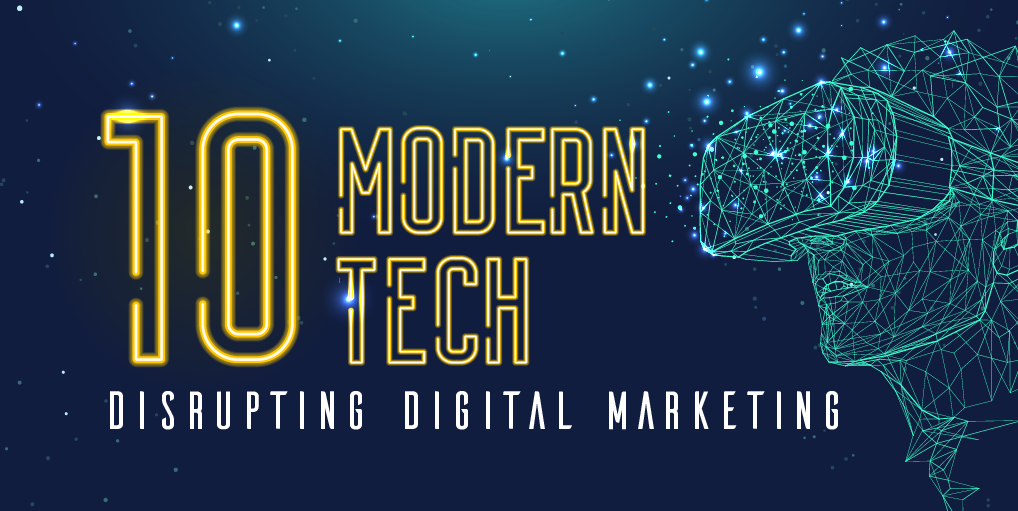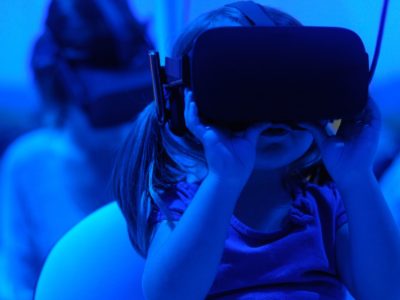Digital marketing came into fruition after the dot-com bubble burst. Significant technological changes like Google going public and the launch of Facebook and YouTube have paved the way to the current state of digital marketing. During this period, these tech companies have controlled most of how companies can collect data and reach their audiences.
As we’re drawing closer to the Fourth Industrial Revolution, a lot of processes and disciplines are expected to be automated, and this includes Marketing—from data gathering to message delivery or vice versa.
Today, a lot of new technology is slowly changing the landscape of digital marketing. According to the World Economic Forum, the four key drivers of these changes are mobile reach expansion, cloud computing, Artificial Intelligence (AI), and Internet-of-Things (IoT). However, newer tech like Big Data and Virtual Reality (VR) are predicted to change the landscape even more.
These new technologies are primarily expected to bring more connectivity to the world through multiple touchpoints, which means that internet giants won’t have as much control over consumer data anymore. More importantly, it will help marketers create more holistic and targeted campaigns in the future.
Below are the technologies that will change the landscape of digital marketing.

Big Data
Cloud technology has opened up doors to both big and small businesses to gather massive amounts of customer data, in part giving way to big data. Today’s corporations know more about customers than ever before, helping them to create accurately targeted and personalized ads.
Then, marketers will analyze data to gain insights on the effectiveness of their campaigns, to understand what works well and what doesn’t so that they can adjust plans accordingly.
But more than just learning the campaigns’ performance, big data may soon be able to determine the channel that worked and converted the best (and inversely, the worst) through attribution models. It may also help in advertising through programmatic advertising (or the automatic purchase of digital ad space) as it can determine the placement and bid, possibly in real time.
Big data may also be used to refine video marketing by gathering data on in-video interactions. By tracking and analyzing the clicks made during a video play, marketers can help move the visitor into the funnel and toward conversion. The videos will be in an interactive platform which applies HTML overlay to online video.
Artificial Intelligence
AI is what made your YouTube or Netflix recommendations possible, as it studies patterns and numbers to gain consumer insights and in turn predict their behavior for better ad targeting. Search engines are also dependent on AI when interpreting queries to come up with relevant results.
In the future, AI may offer a continued connection to customers through chat platforms. Apps with AI scripts can enhance these platforms to learn relevant customer information that may help solve problems or find solutions on demand.
More AI-powered technologies will come up to further improve customer-centric marketing, as it can do better trend analysis and customer profiling for a more sophisticated personalization strategy.
Machine Learning
Machine learning, a subset of AI, has helped organizations automatically discover opportunities, streamline processes, and identify valuable data, aside from doing intelligent audience segmentation and analytics.
However, its most significant opportunities lie in content creation. According to Jordan Kretchmer, a senior director at Adobe, further developments in machine learning can help creators automatically churn out and improve content. Systems can generate headlines and make different formats of content based on which medium to use.
And as these systems gather information on each contents performance, it can also automatically change the headlines to match those that are performing well. Additionally, machines will be able to predict consumer needs even before they are made aware of them.
Personalization may also enjoy the benefits of machine learning, as more developed algorithms can provide a scalable way to create unique experiences for each consumer. It can be programmed to learn everything about a person to offer the experience that he/she will likely enjoy.
Bots
Chatbots are a relatively inexpensive and flexible way for brands to improve customer service as they can quickly give data-related answers and take requests. It can easily be integrated into a website, app, or social media platform, and can gather information to use in marketing strategies.
According to Grand View Research, the global chatbot market is seeing a 24% annual growth rate, with 45% of end users choosing it as the primary mode of communication with brands. In the next five years, it is expected that 80% of brand-to-client communication will be done through bots.
Soon enough, these bots may be utilized to remind consumers to replenish a purchase. With help from Alexa, Siri, and other virtual assistants, buyers may be able to reorder easily, too.
Voice Search
Speaking of personal assistants, voice software is now being utilized more than ever to search, comprising almost 1/3 of the 3.5 billion Google searches performed daily. This change will likely upend paid and organic search strategy practices in the future.
Marketers need to optimize their website based on conversational words. This way, they can have a better chance of being suggested when voice assistants respond to the spoken query. Using keywords that are vice search-friendly can lead to higher CTR. It may also help to start making content in a more conversational tone.
Virtual Reality and Augmented Reality
The AR and VR market is estimated to worth at around $27 billion, perhaps due to organizational marketing needs; it is expected to reach almost $210 billion in four years. AR and VR offer a visceral try-before-you-buy customer experience, allowing them to explore a product, engage with the brand, and buy at the same time—even making them go through a range of senses and emotions.
Soon enough, advertisers and marketers can also harness AR and VR to create short-form storytelling content for brands that will allow for interactive experiences around branded content, which already sounds like a better form of promotion than the traditional ones. Before that, though, they must understand first the distinction between AR and VR’s value proposition and align it with their own KPIs.
When there’s a better understanding of the technology, paired with a better pipeline and original concepts, only then can AR and VR completely blur the lines between high street and online shopping experience.
Internet-of-Things and Wearables
Statista reported that the number of IoT-connected devices would reach 23 billion by the end of 2018 and 75 billion by 2025, with items ranging from toys, sports gear, and medical equipment, to controllable power sockets. The increase in the number of connected devices will result in a web of linked objects that marketers can harness to learn consumer information, including their likes and dislikes.
Indeed, IoT presents a multitude of opportunities for businesses. But one way that IoT can be utilized is in healthcare. Activity trackers and smartwatches that track a user’s heart rate, blood glucose levels, EKG, body temperature, and other biological activities through sensor technology could present a chance for healthcare providers to remotely monitor patients as it can also be internet-connected.
But outside of healthcare, physiological information can be used in understanding how a user truly feels about a brand based on their biological reactions. Emotions can now be a way to gauge the effectiveness of a campaign or a consumer’s interaction with a brand.
Blockchain
You might be more familiar with the blockchain technology through cryptocurrency or Bitcoin, but its potential goes beyond alternative currencies. Marketers can use it to keep audiences engaged in advertisements or to interact with posts or advertisements by leaving feedback or tagging friends.
In addition, it has the potential to disrupt Apple’s or Android’s integrated app platforms and support new cooperative economies. Companies like IBM have planned to study the possibilities of blockchain outside crypto, which may include a mass of applications for the transportation of goods and services.
Beacons
A somewhat unfamiliar technology, beacon was introduced in 2013 when Apple announced iBeacon. Five years later, it was leading the market in proximity marketing technology, accounting for 65% and beating out WiFi and NFC. Around 14.5 million beacons have been in use as of 2017 and may hit the expected 400 million units by 2020.
Beacons are commonly used around physical stores and retail locations to gather detailed information about customers based on their movements and current position to optimize their in-store experience and create highly targeted and personalized messages. Since beacons use Bluetooth, they can be deployed even on areas with poor network reception.
This also allows brands to understand how shoppers navigate and interact in their stores, and use this information to see which elements work for the buyers and which do not so they can make necessary adjustments. The data collected can also help brands in creating the right campaigns that will capture their target buyers’ attention, as it puts the ads directly to them through the mobile device.
Aside from that, beacons can also be used to target potential customers in specific, high-traffic locations and ping out offers to them, or use location-based marketing to direct them to products available online if they are not readily available in physical stores.
5G
The era of 5G is closing in. The fifth generation of mobile network will soon launch with 3GPP, the world regulator of cellular communications standards, approving it. 5G’s increased spectrum chunks, bigger carrier aggregation, and beam-forming and tracking capabilities can significantly improve throughput and efficiency, and provide up to 100 times faster connectivity than 4G with latency by a factor of five.
Clearly, fast connections are necessary when sending out your marketing message or gathering and analyzing valuable information. The arrival of 5G brings forth many changes for both consumers and marketers as better network speeds mean faster page load times, lower bounce rate, and even increased CTR and ROI.
Since loading or streaming is unconstrained by bandwidth and can be done faster, video ads will be crisper and may even utilize VR or AR. Advertisers can better showcase their products and services in rich details.
Faster connections also mean a constant ping of data back and forth between smartphones and connected devices, making it possible for IoT-enabled devices to predict the customer’s next actions. This also means that marketers can grab hold of consumer data insights in real-time to optimize campaigns at the moment and improve location-based marketing.
Wrap-Up
While these new tech mentioned above may seem overwhelming, most of them are still at the infancy stage when it comes to marketing applications. For instance, it may take some time before a whole country or continent can switch to 5G.
This simply means that you still have some time to do more research and to test these technologies within your organization. In time, you’d be able to successfully implement them into your marketing strategies and enjoy the benefits mentioned above.







